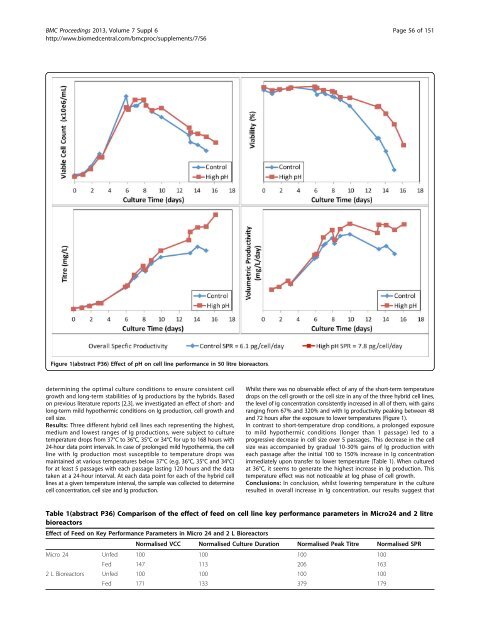Download PDF (all abstracts) - BioMed Central
Download PDF (all abstracts) - BioMed Central
Download PDF (all abstracts) - BioMed Central
You also want an ePaper? Increase the reach of your titles
YUMPU automatically turns print PDFs into web optimized ePapers that Google loves.
BMC Proceedings 2013, Volume 7 Suppl 6<br />
http://www.biomedcentral.com/bmcproc/supplements/7/S6<br />
Page 56 of 151<br />
Figure 1(abstract P36) Effect of pH on cell line performance in 50 litre bioreactors.<br />
determining the optimal culture conditions to ensure consistent cell<br />
growth and long-term stabilities of Ig productions by the hybrids. Based<br />
on previous literature reports [2,3], we investigated an effect of short- and<br />
long-term mild hypothermic conditions on Ig production, cell growth and<br />
cell size.<br />
Results: Three different hybrid cell lines each representing the highest,<br />
medium and lowest ranges of Ig productions, were subject to culture<br />
temperature drops from 37°C to 36°C, 35°C or 34°C for up to 168 hours with<br />
24-hour data point intervals. In case of prolonged mild hypothermia, the cell<br />
line with Ig production most susceptible to temperature drops was<br />
maintained at various temperatures below 37°C (e.g. 36°C, 35°C and 34°C)<br />
for at least 5 passages with each passage lasting 120 hours and the data<br />
taken at a 24-hour interval. At each data point for each of the hybrid cell<br />
lines at a given temperature interval, the sample was collected to determine<br />
cell concentration, cell size and Ig production.<br />
Whilst there was no observable effect of any of the short-term temperature<br />
drops on the cell growth or the cell size in any of the three hybrid cell lines,<br />
the level of Ig concentration consistently increased in <strong>all</strong> of them, with gains<br />
ranging from 67% and 320% and with Ig productivity peaking between 48<br />
and 72 hours after the exposure to lower temperatures (Figure 1).<br />
In contrast to short-temperature drop conditions, a prolonged exposure<br />
to mild hypothermic conditions (longer than 1 passage) led to a<br />
progressive decrease in cell size over 5 passages. This decrease in the cell<br />
size was accompanied by gradual 10-30% gains of Ig production with<br />
each passage after the initial 100 to 150% increase in Ig concentration<br />
immediately upon transfer to lower temperature (Table 1). When cultured<br />
at 36°C, it seems to generate the highest increase in Ig production. This<br />
temperature effect was not noticeable at log phase of cell growth.<br />
Conclusions: In conclusion, whilst lowering temperature in the culture<br />
resulted in over<strong>all</strong> increase in Ig concentration, our results suggest that<br />
Table 1(abstract P36) Comparison of the effect of feed on cell line key performance parameters in Micro24 and 2 litre<br />
bioreactors<br />
Effect of Feed on Key Performance Parameters in Micro 24 and 2 L Bioreactors<br />
Normalised VCC Normalised Culture Duration Normalised Peak Titre Normalised SPR<br />
Micro 24 Unfed 100 100 100 100<br />
Fed 147 113 206 163<br />
2 L Bioreactors Unfed 100 100 100 100<br />
Fed 171 133 379 179

















